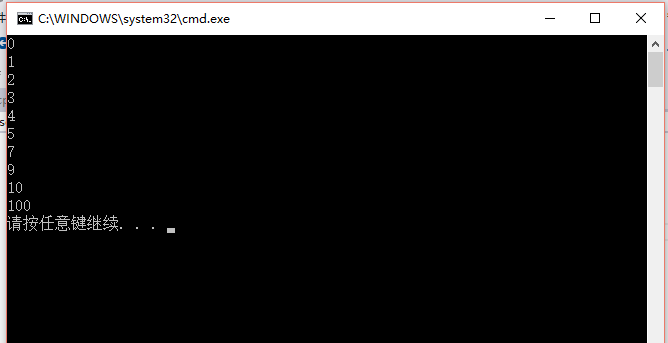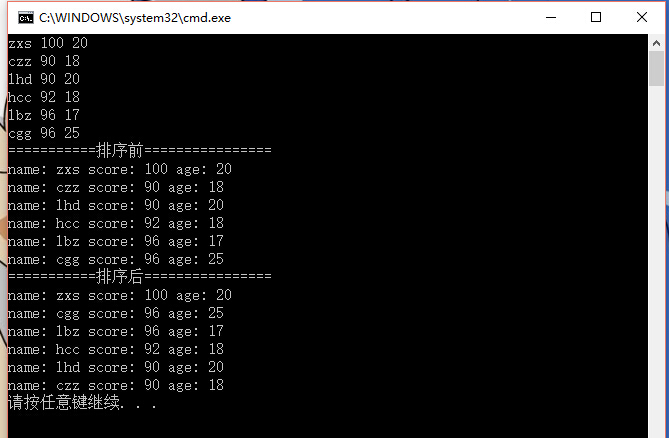關於C++中vector和set使用sort方法進行排序
C++中vector和set都是非常方便的容器,
sort方法是algorithm標頭檔案裡的一個標準函式,能進行高效的排序,預設是按元素從小到大排序
將sort方法用到vector和set中能實現多種符合自己需求的排序
首先sort方法可以對靜態的陣列進行排序
1 #include<iostream>
2 using namespace std;
3 int main(){
4 int a[10] = { 9, 0, 1, 2, 3, 7, 4, 5, 100, 10 };
5 sort(a, a +10);
6 for (int i = 0; i < 10; i++)
7 cout << a[i] << endl;
8 return 0;
9 }執行結果:

這裡可以看到是sort(a,a+10),但是陣列a一共只有9個元素,為什麼是a+10而不是a+9呢?
因為sort方法實際上最後一位地址對應的數是不取的,
而且vector,set,map這些容器的end()取出來的值實際上並不是最後一個值,而end的前一個才是最後一個值!
需要用prev(xxx.end()),才能取出容器中最後一個元素。
對vector使用sort函式:
第一種情形:基本型別,如vector<int>,vector<double>,vector<string>也是可以的
1 #include<iostream>
2 #include<vector>
3 #include<algorithm>
4 using namespace std;
5 int main(){
6 vector<int> a;
7 int n = 5;
8 while (n--){
9 int score;
10 cin >> score;
11 a.push_back(score);
12 }
13 //cout <<" a.end()"<< *a.end() << endl; 執行這句話會報錯!
14 cout << " prev(a.end)" << *prev(a.end()) << endl;
15 sort(a.begin(), a.end());
16 for (vector<int>::iterator it = a.begin(); it != a.end(); it++){
17 cout << *it << endl;
18 }
19 return 0;
20 }執行結果:

看到了嗎,實際上end的前一個指標指向的元素才是插入時的最後一個值!
排序後從小大大。
第二種情形:用自定義的結構體進行sort演算法,
這時候需要自己定義個比較函式,因為sort演算法是基於容器中的元素是可以兩兩比較的,然後從小到大排序,所以要自定義怎麼樣才是小於('<')
1 #include<iostream>
2 #include<vector>
3 #include<set>
4 #include<string>
5 #include<algorithm>
6 using namespace std;
7 struct student{
8 char name[10];
9 int score;
10 };
11 //自定義“小於”
12 bool comp(const student &a, const student &b){
13 return a.score < b.score;
14 }
15 int main(){
16 vector<student> vectorStudents;
17 int n = 5;
18 while (n--){
19 student oneStudent;
20 string name;
21 int score;
22 cin >> name >> score;
23 strcpy(oneStudent.name, name.c_str());
24 oneStudent.score = score;
25 vectorStudents.push_back(oneStudent);
26 }
27 cout << "===========排序前================" << endl;
28 for (vector<student>::iterator it = vectorStudents.begin(); it != vectorStudents.end(); it++){
29 cout << "name: " << it->name << " score: " << it->score << endl;
30 }
31 sort(vectorStudents.begin(),vectorStudents.end(),comp);
32 cout << "===========排序後================" << endl;
33 for (vector<student>::iterator it = vectorStudents.begin(); it != vectorStudents.end(); it++){
34 cout << "name: " << it->name << " score: " << it->score << endl;
35 }
36 return 0;
37 }執行結果:

不過有時候一個排序條件不夠,比如要求學生按分數從高到低排序,如果分數相同,則按照年齡從大到小排序
就需要在comp自定義函式裡面修改一下判斷了,原來是直接return a.score < b.score
現在就需要判斷
if (a.score > b.score) return true; else if (a.score == b.score && a.age > b.age) return true; else return false; 這裡一定要記得else return false!!!有一次比賽的時候寫到這個函式,有三個判斷條件,結果忘了這茬,總是報錯, 到後來有點著急了就自己手動實現了一下寫了三個比較函式,呼叫了三次sort函式!!!!!
1 #include<iostream>
2 #include<vector>
3 #include<set>
4 #include<string>
5 #include<algorithm>
6 using namespace std;
7 struct student{
8 char name[10];
9 int score;
10 int age;
11 };
12 //自定義“小於”
13 bool comp(const student &a, const student &b){
14 if (a.score > b.score)
15 return true;
16 else if (a.score == b.score && a.age > b.age)
17 return true;
18 else ///這裡的else return false非常重要!!!!!
19 return false;
20 }
21 int main(){
22 vector<student> vectorStudents;
23 /*set<student> setStudents;*/
24 //int n = 5;
25 int n = 6;
26 while (n--){
27 student oneStudent;
28 string name;
29 int score;
30 int age;
31 cin >> name >> score>>age;
32 strcpy(oneStudent.name, name.c_str());
33 oneStudent.score = score;
34 oneStudent.age = age;
35 vectorStudents.push_back(oneStudent);
36 }
37 cout << "===========排序前================" << endl;
38 for (vector<student>::iterator it = vectorStudents.begin(); it != vectorStudents.end(); it++){
39 cout << "name: " << it->name << " score: " << it->score << " age: "<<it->age<<endl;
40 }
41 sort(vectorStudents.begin(), vectorStudents.end(), comp);
42 //sort(setStudents.begin(), setStudents.end());
43 cout << "===========排序後================" << endl;
44 for (vector<student>::iterator it = vectorStudents.begin(); it != vectorStudents.end(); it++){
45 cout << "name: " << it->name << " score: " << it->score << " age: " << it->age << endl;
46 }
47 return 0;
48 }
執行結果如下:

接下來,對於set做類似的操作。
set是一個集合,內部的元素不會重複,同時它會自動進行排序,也是從小到大
而且set的insert方法沒有insert(a,cmp)這種過載,所以如果要把結構體插入set中,我們就要過載'<'運算子。
set方法在插入的時候也是從小到大的,那麼我們過載一下<運算子讓它從大到小排序
1 #include<iostream>
2 #include<vector>
3 #include<set>
4 #include<string>
5 #include<algorithm>
6 using namespace std;
7 struct student{
8 char name[10];
9 int score;
10 };
11 //自定義“小於”
12 bool comp(const student &a, const student &b){
13 return a.score < b.score;
14 }
15 bool operator < (const student & stu1,const student &stu2){
16 return stu1.score > stu2.score;
17 }
18 int main(){
19 //vector<student> vectorStudents;
20 set<student> setStudents;
21 //int n = 5;
22 int n = 6;
23 while (n--){
24 student oneStudent;
25 string name;
26 int score;
27 cin >> name >> score;
28 strcpy(oneStudent.name, name.c_str());
29 oneStudent.score = score;
30 setStudents.insert(oneStudent);
31 }
32 cout << "===========排序前================" << endl;
33 for (set<student>::iterator it = setStudents.begin(); it != setStudents.end(); it++){
34 cout << "name: " << it->name << " score: " << it->score << endl;
35 }
36 //sort(setStudents.begin(), setStudents.end(), comp);
37 //cout << "===========排序後================" << endl;
38 //for (set<student>::iterator it = setStudents.begin(); it != setStudents.end(); it++){
39 // cout << "name: " << it->name << " score: " << it->score << endl;
40 //}
41 return 0;
42 }
執行結果:

我們可以看到,set內元素不會重複,而且它按照它所認為的“從小到大”進行了排序

